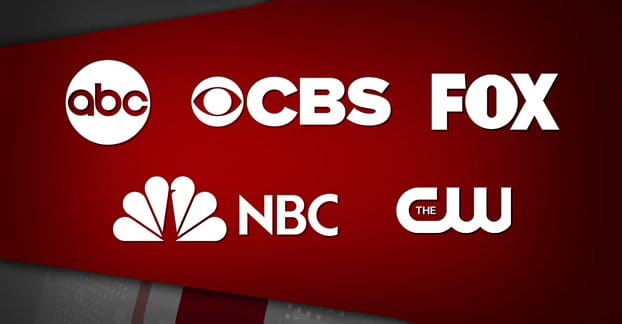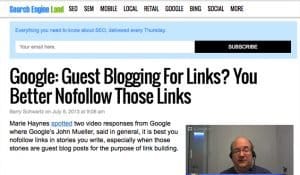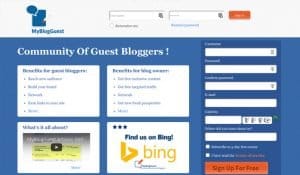Is it possible to have your brand, your app, your event, or your service featured on a large news site for free? If so, it would mean an avenue with immense potential for traffic, for sales, and for exposure.
When I talk about large news sites here, I’m not talking about industry sites. I don’t mean the Search Engine Journal or Moz equivalents for your niche. I mean actual big sites. I mean sites like CNN, the New York Times, the Washington Post, the Guardian, or Forbes. Sites with tens of millions of monthly active users and incredible SEO appeal.
The Basics of Earning a Free Feature
It’s definitely possible to be featured on a large news site for free. You just need the right resources, to come at it from the right angle. All major sites are produced by editors leading teams of writers. Those editors and writers need to get their content from somewhere, right? Sometimes it’s tips, sometimes it’s direct pitches, sometimes it’s sponsorships, but often it’s just seeing what smaller organizations are featuring.
There are essentially three avenues to being featured on a large news site for free.
- Having a truly incredible, exceptional business, product, or portfolio.
- Having an influential friend who can get you an inside hook.
- Working really, really hard.
You’ve seen the first all the time. A news agency does a story on an exceptionally talented origami artist, or a painter who has been blind since birth, or a zookeeper for exotic animals. A large site runs a story on some exceptional and disruptive product, or even just a fad that has taken the country by storm, like fidget spinners, or one of the potentially-fake kickstarted gems like the infinite water bottle, solar roads, or the tiny cube laser engraver.
In the Kickstarter cases, of course, the exceptional aspect is not necessarily the product itself, it’s the proposal and the fundraising. It makes a good story, even if the final product might never exist.
The second one is the more traditional option. Just know someone who can get your foot in the door. You can spend months or years hammering away at the editors on a big name site hoping to get your content featured, with nothing to show for it. But if a friend of that editor says “hold on, I’ll help you out” and shoots off an email recommending that they feature you, you’ll likely find your next pitch accepted, or even a message from them directly inviting you to write something or asking you to interview.
The third one, well, it’s a lot less consistent. You need to work hard and keep your head down until your business is such a success that the big name sites have no choice but to cover you. The problem, of course, is that you end up competing with thousands of other businesses doing the same thing, and there’s nothing that makes you stand out from the pack.
The ideal path to being featured sort of depends on the kind of entity you want to get featured. If you’re an individual looking to have an interview or a profile written about you, it’s different than if you’re trying to get your new iPhone app featured. I’ve given some thought to various broad categories and come up with some advice for you below.
Getting a Business Featured
Most often, you simply want your business featured. You could do something exceptional, and get yourself featured that way, but it’s not necessarily always an available option.
One current example is with the ongoing crisis in Houston Texas. A guy known as Mattress Mack, who owns a large mattress warehouse and furniture gallery in Houston, recognized the need for public assistance in the area due to all of the flooding. Thousands of people are displaced from their homes, and hundreds of them have been able to take shelter in Mack’s furniture stores.
Because of his humanitarian deed, Mack and his business have been featured in all kinds of news publications, large and small. Of course, he didn’t do it just to be featured; he did it out of kindness and recognition of need. He did it to help people, and he’ll be rewarded for it with the publicity and the business of many of these people, who turn to him when they need to rebuild their lives.
This isn’t a replicable business strategy for most of us, of course. Either you don’t have the right kind of business, or you don’t have the right kind of disaster. I would strongly caution you against praying for a natural disaster to strike so you can get some PR, too.
The other, more common route for a business to be featured on high-tier news sites is to work your way up. Basically, you start with a sustained guest post campaign on blogs that you would generally consider your peers or slightly above you in position. These sites are as good or better than yours, but aren’t so much better that they are unlikely to accept your guest posts.
Through this campaign, you gain more exposure, more links, and more brand awareness. With this large base of awareness, you take aim at some blogs a bit higher up on the totem pole. Repeat this process until you’re writing for or being featured on mid-high tier sites, like Inc or Fast Company, sites that the big name sites look to for ideas.
Getting a Product Featured
Product features are tricky. Years and years ago, it used to be possible to simply send out a test version of a product to someone who writes for a big name site – or newspaper as the case may be – and have them use and review it. You could get “free” publicity this way, particularly if they liked it, or you were willing to incentivize them liking it.
These days, it’s rare that anyone who works for a large site like that is willing or able to accept review copies of items, since even that needs to be disclosed and could be seen as an endorsement even if the review isn’t strictly positive. It’s a hassle to track and can come up in discussions with other brands later, so most large sites don’t deal with it. Some might have specific product review channels, so you can try that, but I wouldn’t guarantee it.
One thing I might recommend is watching episodes of the TV show Shark Tank, or the international equivalent, Dragon’s Den. Sure, it’s heavily-edited reality TV, but it gives you an idea of the kinds of products that can get coverage and the kinds that can’t. One thing you’ll often see is that the investors look for products that are innovative or fill a niche that otherwise hasn’t been well covered. Some examples of Shark Tank successes:
- Breathometer, a device with a smartphone app that acts as a portable breathalyzer, aimed at reducing instances of drunk driving.
- Bombas, an athletic sock company with a philanthropic mission; each pair purchased leads to a pair donated to the homeless. The product isn’t unique, but the mission is.
- Groovebook, a company that helps you put together a physical photo book with photos from your smartphone. Since it’s grown harder to get photo prints in the age of digital imagery, this fills a role for people who want a convenient and consistent source of physical memories.
- XCraft, a drone designed for fast horizontal flight, along with an expansion that slips a smartphone into a drone shell for a cheaper way of taking photos or videos. On the show, the investors talked about many different applications, ranging from surveying land to television production to the defense industry. It’s an extremely flexible product that could be licensed for a wide variety of applications.
Having a disruptive product, an innovative product, or a unique spin on an existing product can get you a lot of publicity.
One recurring element with successful products seen on shows like Shark Tank is the philanthropic element. Several of the most successful companies have associated donations to charities, to homeless shelters, or to infrastructure expansions in other countries. If you can institute some kind of program in a similar vein, you can get publicity simply by getting big name sites to promote your philanthropy. People love donating by proxy and getting something in return; it makes them feel like their capitalist spending habits are helping others and not just themselves.
Getting an App Featured
Apps are a little harder to get featured simply because you need to be something truly out of the ordinary. You can take a number of different paths for this. For example, there are apps like I Am Rich, which was a $999 app that did nothing but put a shiny icon on the phone screen, or Send Me To Heaven, an app that encouraged throwing your phone as high into the air as possible – leading to damage when you inevitably failed to catch it.
Other apps can simply fill a role that hasn’t been filled, or hasn’t been filled well, before. Apps like Tinder or Snapchat obviously fill these roles, but so do simple innovative games like Angry Birds or the fad Flappy Bird from a couple years back.
One of the troubles with featured apps is simply that it’s incredibly easy for a farm developer in China or India to reverse engineer or copy your app and try to get it going as a competitor. Those won’t get publicity on their own, but they make your app look less unique.
Getting an Event Featured
Getting an event featured generally just comes down to either having the right connections or being big and/or unique enough. For example, a large gathering or convention – something like Lollapalooza or San Diego Comic Con – is going to get a lot of publicity, because they’re massive events every year. Something like the recent anniversary event for Pokemon Go got a lot of attention both because of how big and unique it was and because of how poorly it went.
Unfortunately, smaller events are likely only going to be featured in local papers and local sites unless they grow to an exceptional level. It’s pretty difficult to get a small event – anything smaller than a state fair, really – to get national-level coverage. You need to have something of national appeal. Well, that, or you could go wrong in a spectacular way, like the cheese festival that ran out of cheese, or FyreFest.
Getting an Individual Featured
As an individual, if you want to be featured on some kind of national publication, you need to either do something extremely noteworthy, be extremely rich, or have well-connected friends. There’s not really any way around it. Sites like Forbes, the Huffington Post, or the Washington Post aren’t going to just write a story about any old regular business owner for no reason.
Now, when I say do something noteworthy, I don’t mean that you need to personally shoot down 100 Nazi warplanes or donate $100,000,000 to charity. You can be a pretty simple small business owner with a focus on humanitarian aid. I mentioned Mack up above; he’s getting as much publicity and as many interviews as his business, after all.
The easiest way, for all of the above, is really just to make friends with people in high places. Network with people, meet journalists at trade shows, associate with ever-increasing circles of society, and ruthlessly pursue publication. Eventually you’ll make it.
 ContentPowered.com
ContentPowered.com







